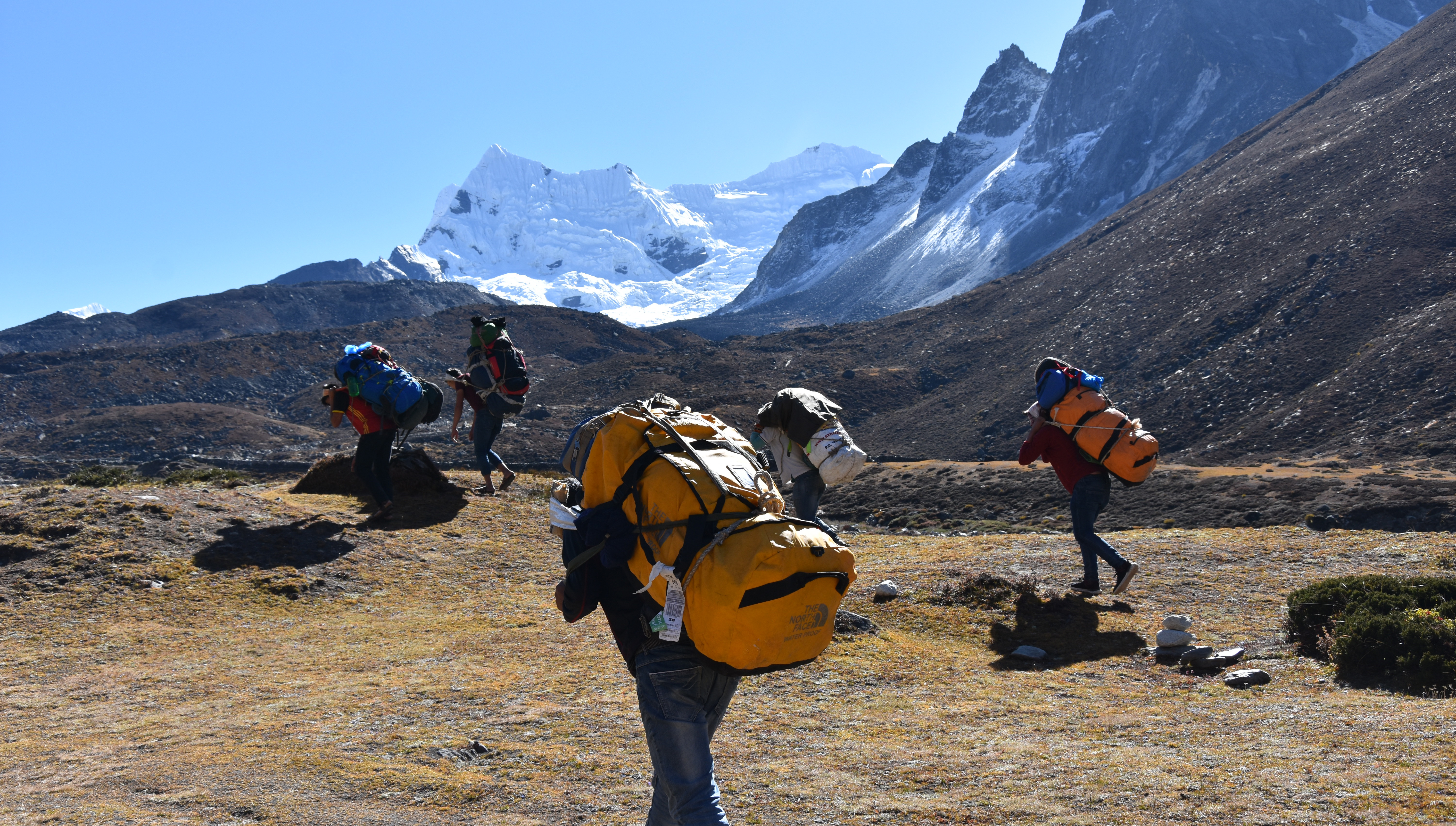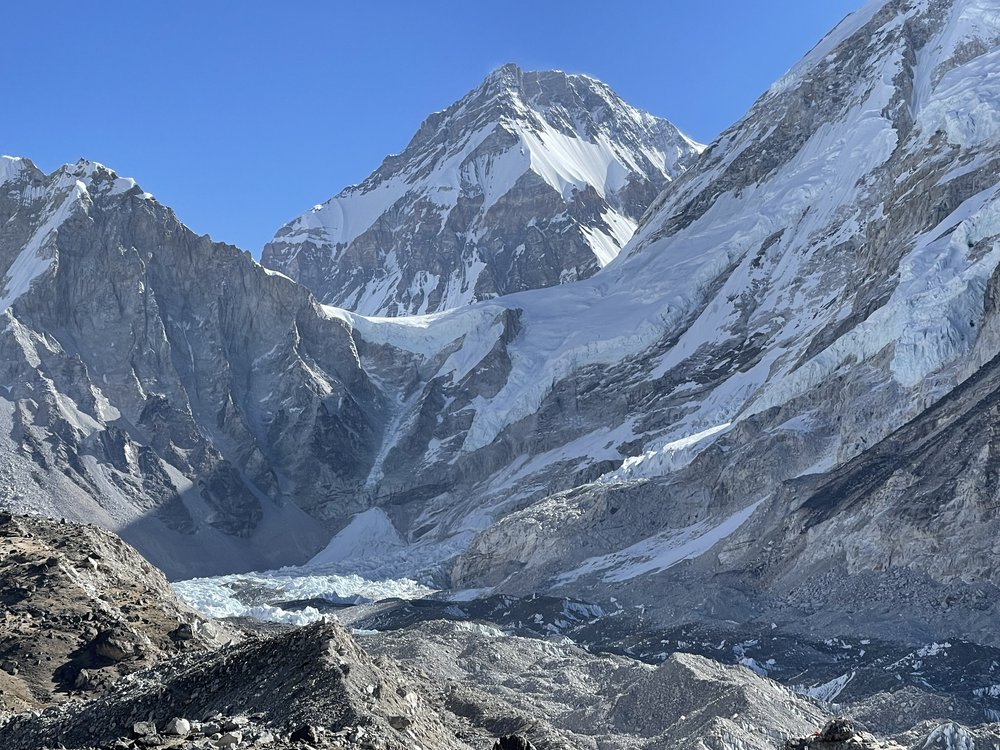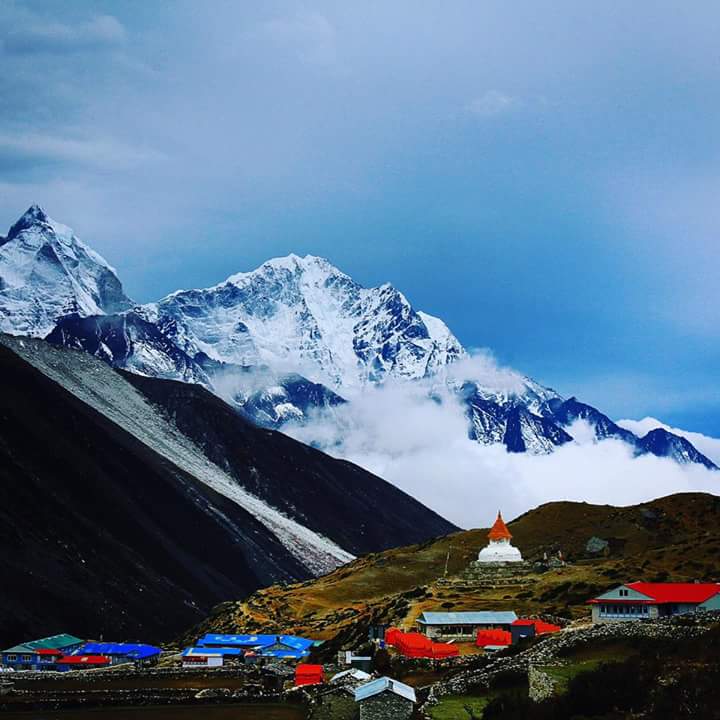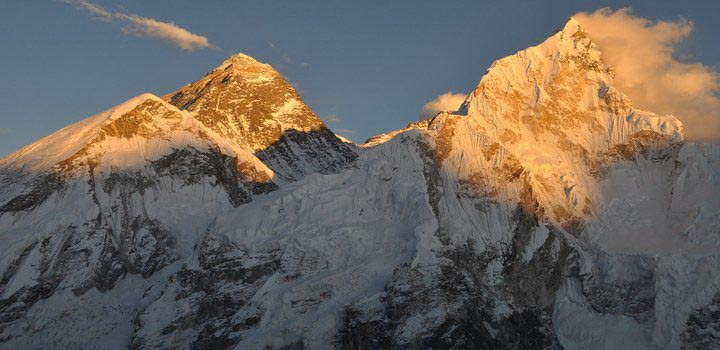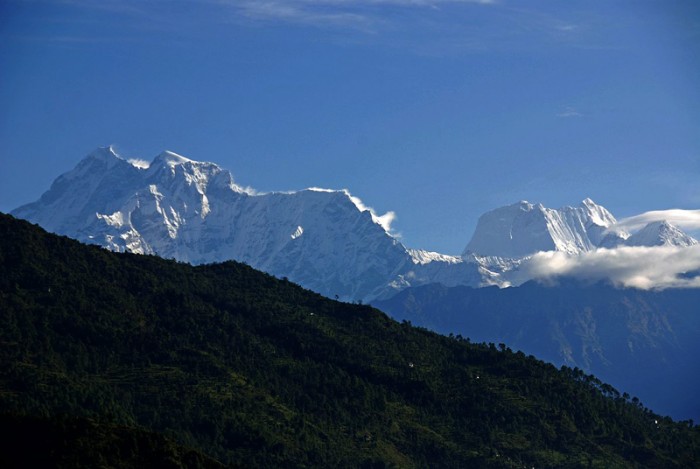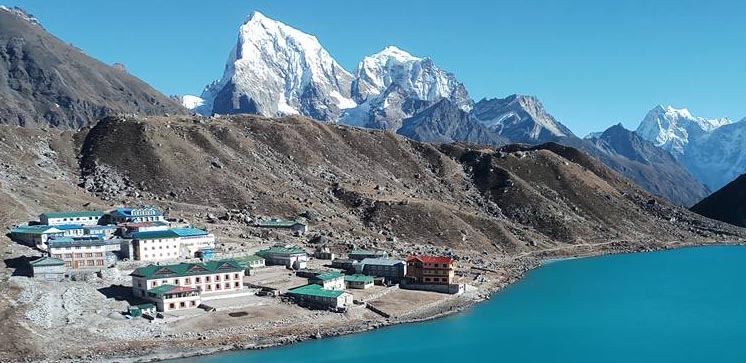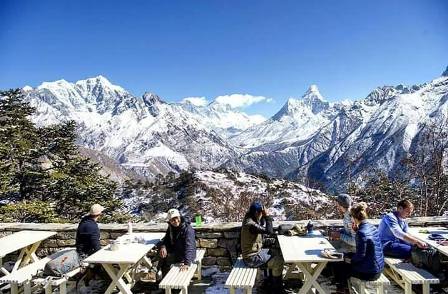Everest Base Camp Trek
Everest Base Camp Trek, is the most prevalent trekking destination. The base camp trek is a dream for many travelers around the world. A lifetime memorable experience for travelers to witness the breathtaking views of the world’s highest mountain sceneries. The journey to the Everest base camp trek is full of an impressive landscape, beautiful peaks, and glaciers, ancient monasteries, and snow-capped mountains.
Everest Base Camp Trek begins with an adventurous flight to Lukla. The colorful Namche Bazaar, the lovely Sherpa people, and their culture, the side trip to Kalapatthar, Everest Base Camp, the stunning views of Everest, Nuptse, Lhotse, Ama Dablam, and the huge Khumbu Glacier make this Everest Base Camp Trek experience unforgettable.
Day 01: Arrive in Kathmandu (1,400 m).
Day 02: Kathmandu Vally Sightseeing
Day 03: Fly to Lukla (2,804 m) and Trek to Phakding (2,610 m) – 3 hours.
Day 04: Trek to Namche Bazaar (3,441 m) – 5 hours.
Day 05: Namche Bazaar Acclimatization Day.
Day 06: Trek to Tengboche (3,860 m) – 5 hours.
Day 07: Trek to Dingboche (4,350 m) for 4 – 5 hours.
Day 08: Acclimatization Hike to Nangkartshang Peak (5,083 m) 3 – 4 hours.
Day 09: Trek to Lobuche (4,910 m) 4 – 5 hours.
Day 10: Trek to Everest Base Camp (5,365 m) & walk to Gorak Shep (5,180 m) 6 for – 7 hours.
Day 11: Morning Hike to Kala Patthar (5,555 m) & descend to Pheriche (4,200 m) 5 – 6 Hours
Day 12: Trek to Namche Bazaar (3,441 m) – 7 hours.
Day 13: Trek to Lukla (2,804 m) 5 – 6 hours.
Day 14: Flight from Lukla to Kathmandu.
Day 15: Transfer to the International Airport for Departure.
Day 01: Kathmandu Arrival (1,350m/4,428ft)
Our Himalayan Sanctuary representative welcomes you at the International Airport upon your arrival. After completing all formalities, you are transferred to the hotel in Thamel. Overnight at a hotel in Thamel, Kathmandu.
Day 02: Kathmandu Valley Sightseeing (4-6 hrs)
After breakfast, you proceed to the Kathmandu Valley sightseeing places. Firstly, a visit to the Tibetan Buddhist pilgrimage site Boudhanath Stupa. The golden spiral stupa surrounded by souvenir shops, cafes, and restaurants is amazing. Also, rotate the Mani wheels below the stupa and take a round of the stupa. After that, visit the Hindu holy temple Pashupatinath. The richly decorated pagoda temple has the phallic symbol of Lord Shiva. The big bull outside the temple and other small temples in the surrounding are attractive. From there, a visit to the Swayambhunath Stupa. It is widely known as the Monkey Temple. A stunning view of Kathmandu city from the top. The big Vajra, many gold-plated Buddha statues, a monastery, small temples, and many monkeys are fascinating to observe. We end the tour by traveling to Patan Durbar Square. Patan City is an ancient old city renowned for its culture, tradition, festivals, heritages, and arts & crafts. Get amazed by the beauty and cultural heritage of this place. The well-carved and designed temples, Patan Museum, Krishna Mandir, and decorative courtyards are major attractions. Enjoy some delicious cuisine in Patan and return to Kathmandu. Overnight in Kathmandu.
Included Meal: Breakfast
Day 03: Kathmandu – Lukla – Phakding (2,651m/8,700ft): 30-minute flight, 3 – 4 hours trek
In the morning, take a scenic flight to Lukla from Kathmandu. After that, a trek to Phakding commences via Cheplung village. Get a glimpse of Mt, Khumbila on the way. Overnight at Phakding.
Included Meals: Breakfast, Lunch, and Dinner
Day 04: Phakding – Namche (3,438m/11,280 ft): 4- 5 hours
A trek to the Sherpa capital Namche begins. Walking through the Benkar valley and we traverse the Dudh Koshi River. Proceed further and walk through Chumoa and Monjo villages and enter the Sagarmatha National Park. From there, cross a suspension bridge to reach Jorsale village. Ascend uphill and arrive at Namche. Overnight in Namche.
Included Meals: Breakfast, Lunch, and Dinner
Day 05: Acclimatization Day – Namche Bazaar: (3,440m/11,284ft)
An acclimatization rest at Namche Bazaar to adjust easily to the altitude. We explore Namche today by exploring the surrounding places. Visit the Sagarmatha National Park and witness some diverse flora. If lucky get some glimpse of wild animals too. Admire the stunning views of Mt. Lhotse, Nuptse, Ama Dablam, and other snowy mountains. After that, we can also visit Khumjung village or rest at a hotel. Overnight in Namche Bazaar.
Included Meals: Breakfast, Lunch, and Dinner
Day 06: Namche Bazaar to Tengboche (3,870m/12,694ft): 5- 6 hours
A pleasurable walk to Phunki. From Phunki, ascend towards Tengboche and visit the largest Tengboche Monastery in the Everest region. Observe some great views from the monastery including Mt. Lhotse, Nuptse, and Thamserku. Rest at a guesthouse. Stay Overnight.
Included Meals: Breakfast, Lunch, and Dinner
Day 07: Tengboche to Dingboche (4,358m/14,295 ft) 5 – 6 hours
A descend walk to Debuche and traverse the Imja River. Proceed further and reach the village of Pangboche. Explore the oldest Pangboche monastery. Reach our destination Dingboche via Imja Valley. Stay Overnight.
Included Meals: Breakfast, Lunch, and Dinner
Day 08: Dingboche: Acclimatization (4,358m/14,295 ft.)
An acclimatization rest day at Dingboche. A short hike to the hill behind Dingboche to adjust to the altitude and get a glimpse of Mt. Lhotse, Makalu, and Cho Oyu. Overnight at Dingboche.
Included Meals: Breakfast, Lunch, and Dinner
Day 09: Dingboche – Lobuche (4,928m/16164 ft.)
A long trail continues admiring the scenic views. Pass through lovely settlements and traverse Dughla Pass and reach Lobuche. Stay Overnight.
Included Meals: Breakfast, Lunch, and Dinner
Day 10: Lobuche – Gorak Shep (5,160m/16,929ft) – Everest Base Camp (5,320m/17,450ft)
A prime point of our trek comes as a trek to the Everest Base Camp commences. A long-hour trek yet a fruitful experience. Reach Gorakshep and have lunch. From there, trek to the Everest Base Camp onwards. Upon reaching the base camp, relish the spectacular views of Mt. Pumori, Khumbu, and Nuptse. Return to Gorakshep and stay overnight.
Included Meals: Breakfast, Lunch, and Dinner
Day 11: Gorakshep – Kalapatthar (5,550m/18,204ft) – Pheriche (4200 m)
A thrilling trek to the highest point Kalapatthar for a stunning close-up view of the world’s highest Everest and surrounding snowy mountains. Snap some photos and enjoy some time in the vicinity. Return to Gorakshep and have lunch. Trek down to Pheriche and spend a night at a guesthouse.
Included Meals: Breakfast, Lunch, and Dinner
Day 12: Trek to Namche Bazaar (3,500m/11,480ft) – 7 hours
An enjoyable walk to Namche Bazaar. A slow descent walks adoring the sceneries through Pangboche and Tengboche. Arrive at Namche and rest for a while at the hotel. Explore the Bazaar, eat some bakery items, or buy some souvenirs in the evening. Overnight at a guesthouse.
Included Meal: Breakfast, Lunch, and Dinner
Day 13: Trek to Lukla (2,804 m) – 6 hours
Our last day of trekking in this Everest region. We trek to Lukla and reminisce about the wonderful adventurous journey towards the Everest Base Camp. Enjoy the last day in the lap of mountains, relax, take a hot shower, and have some celebrations upon accomplishing the trek. Overnight at a guesthouse.
Included Meal: Breakfast, Lunch, and Dinner
Day 14: Lukla – Kathmandu (1400 m)
An early morning flight from Lukla to Kathmandu. Bid adieu to this wonderful mountainous place and enjoy the last scenic flight from Lukla. Upon reaching Kathmandu, rest and relax at the hotel. In the evening, join us for a cultural dinner and share some of the experiences. Overnight in Kathmandu.
Included Meals: Breakfast and Dinner
Day 15: Departure Day
Our representative bids farewell to you at the Tribhuvan International Airport for your onward destination. Have a safe journey.
Included meals: Breakfast
Note: To avoid the risk of missing your International flight we always suggest you have 2 to 3 days extra at the end of your trip because the flight from Kathmandu – Lukla – Kathmandu is often delayed or canceled due to bad weather conditions. If the flight to Lukla is canceled for more than 3 days, then, in that case, we will possibly change the itinerary for something equally better alternative trek.
Cost Included
- Airport pickups and Drop
- 3-star category hotel in Kathmandu with Breakfast
- Teahouse accommodation including Breakfast, Lunch, and Dinner during the trek
- Domestic flights (Kathmandu- Lukla -Kathmandu)
- City tour in Kathmandu by private vehicle
- An experienced, English-speaking, and government-licensed trekking guide.
- Porter service (1 porter will be provided for 2 trekkers)
- Duffel Bag
- Staff costs including their salary, insurance, equipment, domestic airfare, food, and accommodation
- All necessary paperwork and trekking permits (National Park Permit, TIMS)
- Farewell dinner at the end of the trip
- Medical kit (carried by your trek leader)
- All government and local taxes
Cost Excluded
- Nepalese visa fee
- Excess baggage charge(s)
- Entrance Fee for Sightseeing
- Extra night accommodation in Kathmandu because of early arrival, late departure, or early return from the mountain (due to any reason) than the scheduled itinerary
- Lunch and evening meals in Kathmandu (and also in the case of early return from the mountain than the scheduled itinerary)
- International flights
- Travel and rescue insurance
- Personal expenses (phone calls, laundry, bar bills, hot and cold drinks, battery recharge, extra porters, bottle or boiled water, Tea, Coffee, hot shower, etc.)
- Tips for guide(s), porter(s) and driver(s)
The following personal items give you a general idea of that need to bring for the trek. The personal items are of individual interest and choice. The most important fact that one should keep in mind is that one should have enough clothes to tackle the cold weather in the Himalayas.
Upper Body – Head / Ears / Eyes
- Sun hat
- Wool or synthetic hat that covers the ears
- Sunglasses with UV protection
- Headlamp
- Neck warmer
Hand
- Liner gloves
- Heavier shell gloves
Core Body
- T-shirts (2)
- Lightweight expedition thermal tops
- Fleece jacket or pullover
- Water/windproof shell jacket (Preferably breathable fabric)
- Synthetic sports bras (for women)
Lower Body – Legs
- Lightweight expedition thermal bottoms
- Nylon hiking shorts
- Soft shell and hard shell trekking pants
- Water/windproof trousers
- Casual pants
Feet
- Liner socks
- Heavyweight socks
- Waterproof hiking/trekking boots
- Light shoes/sneakers
- Gaiters (For monsoon and winter)
Other Essential
- Passport and extra passport photos (2 copies)
- Airline tickets (Please make a copy and leave one at our office in KTM just in case you need to change the date of yours)
- Durable wallet/pouch for travel documents, money & passport
- Water bottle/bladder
- Water purification Iodine tablets
- Toiletries (Include toilet paper, wet wipes, and liquid hand sanitizer, towel, soap)
Medicines and First Aid Kit
- Extra Strength Excedrin for altitude-related headaches
- Ibuprofen for general aches and pains
- Immodium or Pepto bismol capsules for upset stomach or diarrhea
- Diamox (commonly prescribed as Acetazolamide) 125 or 250 mg tablets for altitude sickness
- Anti-infection ointments
- Band-aids
- Lip balm (At least SPF 20)
- Sunscreen (SPF 40)
Optional
- Adjustable trekking poles
- Favorite snacks
- Paperback books, cards,
- Cameras (Memory cards, chargers, and batteries)
Skills :
Your familiarity with the mountainous terrain and previous trekking experience will be plus points.
Fitness Level:
This Trip Requires being in Good Health with Physically Fitness.
Note: This equipment list is only a guideline. You need to bring the listed items, however, you can choose from your preferred brands using your expertise. You can also shop the above equipment and clothing at a reasonable price at stores in Thamel, Kathmandu.
1. Will somebody come to pick me up at the airport upon my arrival?
One of the representatives from Himalayan Sanctuary Adventure will be waiting outside the airport terminal displaying your name.
2. What sort of accommodation can I expect in Kathmandu and trekking?
We use standard rooms at 3* category hotels in Kathmandu and you will be accommodated at the best Normal teahouses/lodges along the trekking routes which provide the finest facilities in the mountains. The lodges in trekking routes usually provide single and double rooms. At times when possible, dining will be around a bonfire. In tea houses, food will be prepared in the kitchen which you should not enter without permission. Up until Dingboche, you will have an attached toilet and bathroom. But in two locations Lobuche and Gorakshep, you will have to use a common toilet and bathroom. (depend on the Season)
3. Is it possible to swap my accommodation from a mountain guesthouse to a hotel in Kathmandu?
Substituting the accommodation or swapping from the mountain guest house to Kathmandu is NOT possible. We only provide two nights’ accommodation in Kathmandu included in the package. In case of flight cancellation or early arrival to Kathmandu due to any sickness in the mountain or any of your reason or due to bad weather and you are unable to continue the trek, you will need an extra night accommodation/s in Kathmandu. We can make these arrangements for a supplemental charge.
4. Is it possible to reserve a trip now and pay a deposit later or do I HAVE to pay a deposit at booking/reservation?
Yes! The trip will be confirmed only when we receive the completed final booking form and a 30% deposit payment. You can pay the balance of the money when you arrive in Kathmandu.
5. Is there a possibility of getting separate rooms for the Kathmandu portion of the trip? If so how much extra will this cost?
Yes! We can surely book separate rooms in Kathmandu for your portion of the trip. During the trek, we will try our best but normally the lodges have twin-sharing and dormitory-styled rooms instead of a single room.
6. Is this a guaranteed departure even if I am alone starting on the requested trip?
YES, all our trips are guaranteed to run. We never cancel the trip due to not having enough participants, we can arrange the trip for one person as well.
7. When I pay the remainder of the money on arrival in Kathmandu, how do you take that money? US cash or credit card?
You can clear the remainder of the money upon your arrival in Kathmandu or even before you arrive in Kathmandu. You can use USD, Euro, Pound, Canadian Dollar, Swiss franc in cash, Master, or Visa cards for the payment options. There will be a 4% bank levy when paying by credit card.
8. What sort of food can I expect in trekking?
Most teahouses (lodges) in Everest Base Camp trails cook a delicious range of mostly vegetarian fare. Pasta, tuna bakes, noodles, potatoes, eggs, daal Bhat (rice and lentils), bread, soup, fresh vegetables (variety depends on the season), and even some desserts like apple pies, pancakes, and some interesting attempts at custard. You will find a lot of garlic on the menu because it assists with acclimatization – eat some every day. In many larger villages, you may find some meat items on the menu. You can always get hot chocolate, tea, and hot lemon drinks, as well as soft drinks, and treats like chocolate and crisps. Each day dinner and breakfast will be at a lodge you’ll stay at while lunch will be taken on the way to the destination
9. Is the food in the mountain prepared to international standards in terms of safety?
YES, the food is very safe during the trekking but we recommend you to eat vegetarian and local food. Please follow the suggestion of our guide on the trek.
Bottled water is easily available at the lodges and tea houses. You can buy bottled water at the cost of USD 2 at lower elevations and up to USD 4 at higher elevation per littler. You can also drink the normal tap or spring water if you bring the purifying aid with you.
11. What is the alternative option if my flight to and from Lukla is canceled or delayed?
Twin Otter and Dornier is the primary mode of transport to and from the airstrip at Lukla. This service is fairly dependable. Sometimes, flights (to and from Lukla) may be canceled due to mountain weather conditions or technical issues. In such a case, Ace the Himalaya can help you charter a helicopter to ensure you are on schedule for your trek or international flight. The helicopter can fly if the visibility is 1500m, while the twin otter and Dornier can fly if the visibility is 5000m, as per Nepal’s Civil Aviation rules. If the weather is extreme and the visibility is lesser than 1,500m helicopters are also not operated for the flights. In such cases, we will reschedule your flight for the next day providing you with alternative trek options.
The cost of the helicopter is payable directly to our Kathmandu office if this service is utilized. US cash or credit cards (Visa Cards, Master Cards, American Express only) are accepted. You will be given a receipt upon payment so that you may claim the amount from your travel insurance. The extra charges incurred are approximately USD 2,500 to USD 3,000 per helicopter (minimum USD 500 to maximum USD 3,000 per person) would apply to you for the helicopter charter. Usually, the helicopter takes only 3 to 5 passengers at a time. Therefore whatever the cost of a helicopter is, the price is divided among the group members. Any card payment requires a 4% bank fee while doing the transaction, which is taken by the bank itself. (Himalayan Sanctuary Adventure doesn’t own any of those 4% amounts).
Our trekking season extends from mid-September to May. From early September the monsoonal rains decrease. By the end of September through to December, the weather is usually stable with mild to warm days, and cold nights. February, March, April, May, October, November, and December is the best time to do Everest base camp deluxe trek
YES, you can obtain a visa easily upon your arrival at Tribhuwan International Airport in Kathmandu. A tourist Visa with Multiple Entries for 30 days can be obtained by paying US $ 40 or equivalent foreign currency. Similarly, a Tourist Visa with Multiple entries for 90 days can be obtained by paying US $ 100. Please bring 2 copies of passport-size photos.
Wherever possible we utilize the toilet facilities provided by the tea houses/lodges on the trail. However, in case of emergency trekkers are recommended to find a private, scenic spot!
20. What are the Toilet facilities in the tea house/guesthouse?
Most of the tea houses do have western-style flushing toilets however tea houses at higher elevations you could find the squat toilets made of either a ceramic basin on the ground or a few planks precariously positioned over a hole in the ground which is always outside.
21. Is there a possibility of getting separate rooms for the trip? If so how much extra will this cost?
Normally the lodges have twin-sharing and dormitory-styled rooms. The lodges will provide a private room for one person when available. In Kathmandu, USD 45 Per Room per Night would be added as a single supplement fee. The single supplements are always guaranteed in Kathmandu but not in the mountains especially during the peak time.
| Start Date | End Date | Price in USD | Availability | Booking | Note |
|---|
Avabillity Options
OPEN: This date is available and open for bookings. Go for it!
GUARANTEED: Guaranteed departure. Seat Available.
LIMITED: Guaranteed departure, Limited seat. You can send booking request for availability.
FULL:This date is currently unavailable. Please contact us if you are interested in traveling on this date.



